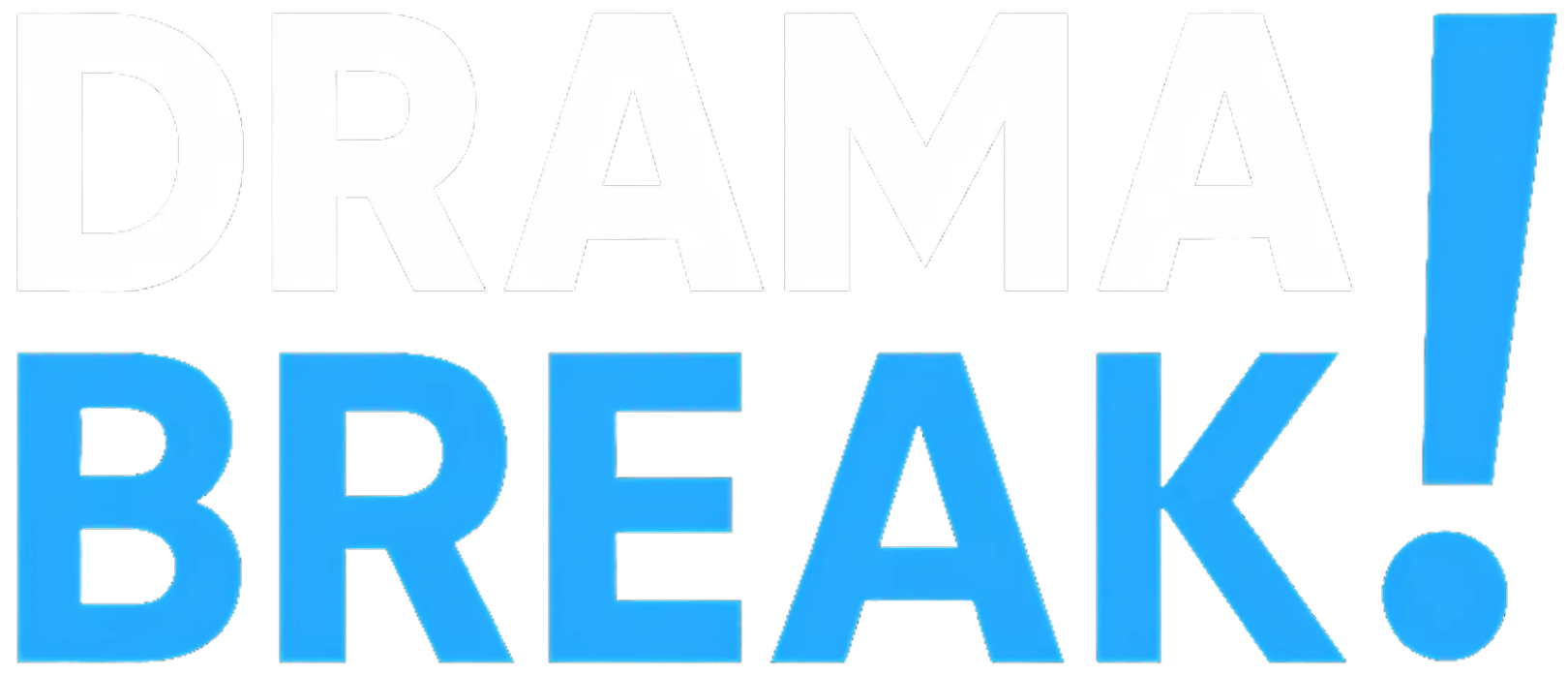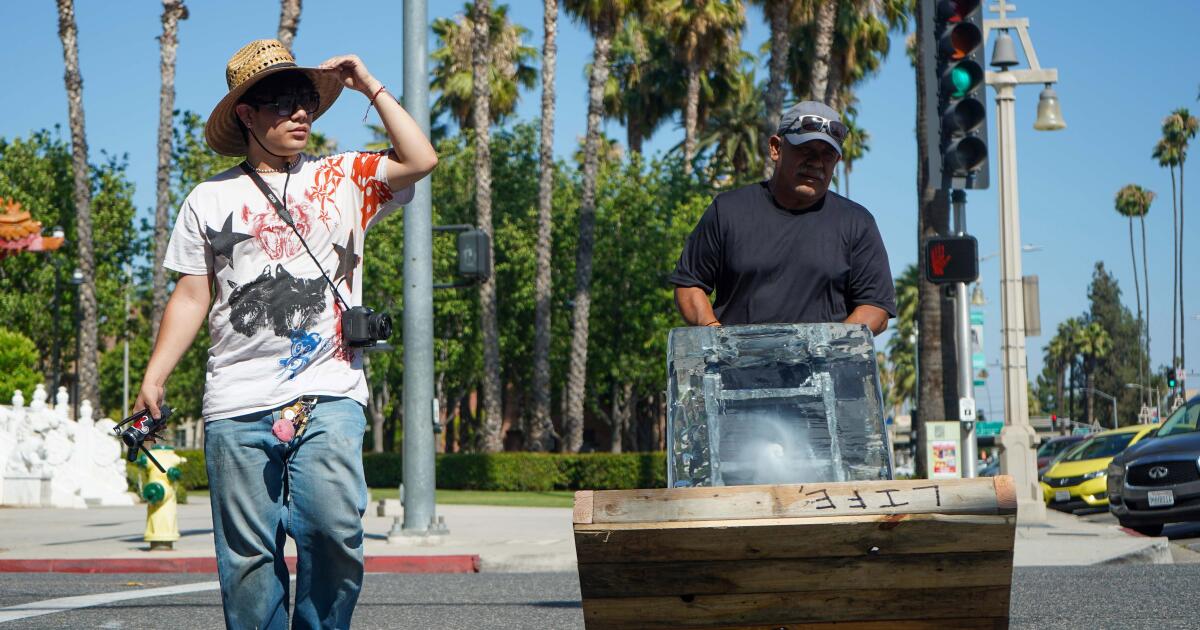Some SoCal residents spent their summer time on the seaside, or at their native rooftop pool; others spent it indoors, hiding from ICE brokers.
It’s why Riverside artist Perry Picasshoe spent his summer time documenting the melting of 36 ice blocks on sidewalks throughout the Inland Empire.
He traveled to 9 places, a mixture of parks, storefronts and fuel stations, the place immigration enforcement raids have taken place previously few weeks. In every spot, he positioned 4 25-pound ice blocks on the bottom and took pictures of them as they melted. He would periodically examine on the progress, he defined, and located that some have been smashed into items or utterly disappeared.
“I took it as a metaphor of what’s occurring,” Picasshoe mentioned, referencing the latest ICE raids happening throughout Southern California. “I used to be additionally considering lots about having these blocks of ice as virtually a stand-in for individuals.”
This newest artwork piece is simply one of many many different Chicano-focused initiatives that Picasshoe has created in his hometown previously three years. His purpose, amongst all the artworks, is to push its residents to mirror on the complexity of the Inland Empire’s Latino identification.
Perry Picasshoe and his father place an ice block close to the epicenter of the town’s month-to-month arts stroll in downtown Riverside on July 3, 2025.
(Daniel Hernandez)
Juan Carlos Hernandez Marquez is an rising Mexican American multidisciplinary artist from Riverside who goes by the stage title Perry Picasshoe. The moniker, which he created as a young person, is a play on Pablo Picasso’s title blended with an early 2010s social media time period “artwork hoe.” Beneath this pseudonym, Picasshoe first gained recognition for creating artwork that explored the complexities of his dueling identities of being an LGBTQ+ artist whereas surrounded by conventional Latino beliefs.
Whereas learning visible arts at UCLA, he reimagined Sandro Botticelli’s portray “The Start of Venus” with LGBTQ+ imagery, created a 9-foot-tall Christmas cactus in honor of the time he spent together with his father in the course of the holidays and hosted a solo exhibition referred to as “Mystic Backyard,” which showcased items impressed by flowers given to him by an ex-partner. It’s additionally the place he developed his signature red-dominant fashion in each his trend and artwork.
“Pink is my consolation coloration,” Picasshoe mentioned.
He suffered from occasional panic assaults whereas learning at UCLA, he defined, which discouraged him from going to high school. It continued for months — till he discovered himself sporting a brilliant purple outfit, which introduced him a way of peace.
“It simply sort of grew from there,” he added. “It simply adopted me in all places that I went.”
Picasshoe additionally posted movies showcasing his items on social media. Like his art work, his posts have been intricately filmed and edited with brilliant purple accents. They have been additionally accompanied by narration detailing the work’s inspiration, creation course of and which means. His efforts amassed him virtually 200,000 followers between TikTok and Instagram.
This fast development, each on social media and inside his community, introduced new alternatives to develop professionally in Los Angeles. But after graduating in 2022, he determined to proceed his profession in his hometown as a substitute.
“It was only a completely different tempo that I used to be not prepared for,” he mentioned. “The artwork scene out right here is rather more [based in] neighborhood, versus [money] or clout. It’s extra of constructing work that folks right here will get to get pleasure from.”
It’s a choice that’s labored in his favor.
This 12 months, he’s been honored by the town on the Mayor’s Ball for the Arts with the Rising Artist award and acknowledged as one among UCLA’s high 100 alumni entrepreneurs for 2025. Picasshoe’s resolution to be an expert artist inside the Inland Empire additionally got here at a time when alternatives for Latino artists within the area have grown lately.
Cosme Cordova, long-time Riverside Chicano artist and Division 9 Gallery founder, defined that for many years, Latino artists thought of Riverside a “boot camp” as a substitute of a metropolis the place they might make a residing. They might earn some cash of their hometown, then journey to different distinguished places, like Los Angeles or Palm Springs, the place artists felt their work was extra revered. Because the years went on, he mentioned, the local people started to know the worth in supporting its artists.
“Then when the Cheech got here, it’s acquired worldwide consideration, so it’s simply gotten even higher,” Cordova mentioned. “I’m beginning to see a variety of artists now extra genuinely centered on simply making an attempt to showcase their work right here in Riverside.”
Probably the most distinguished addition inside the area has been the Cheech Marin Middle for Chicano Artwork and Tradition — recognized colloquially as “the Cheech.” The museum is extensively thought of the one area within the nation that completely showcases Latino-made exhibitions, together with a few of Picasshoe’s work.
Since returning to the Inland Empire, Picasshoe’s creative imaginative and prescient caught the eye of each neighborhood leaders and bigger establishments. Whereas internet hosting one among his first solo exhibitions, referred to as “Pink Ideas,” on the Eastside Arthouse in Riverside, the administrators of the Cheech took discover of his distinctive fashion.
“They method their work with abandon, with any medium,” mentioned María Esther Fernández, the middle’s creative director. “That they had an set up and it was very interactive and immersive. I feel pushing the boundaries of that’s actually enjoyable and revolutionary.”
It could lead Picasshoe to work on a variety of initiatives in collaboration with the Chicano artwork heart for the following three years.

Perry Picasshoe stands in entrance of the Cheech Marin Middle for Chicano Artwork & Tradition in Riverside, Calif., on July 3, 2025.
(Daniel Hernandez)
Final 12 months, Picasshoe teamed up with Inland Empire-based artist Emmanuel Camacho Larios to curate an exhibition for the Cheech’s neighborhood gallery referred to as “Desde los Cielos.”
“It was a gaggle present that explored what the time period ‘alien’ meant within the context of Chicanxs, and alien within the political, the social and the queerness of all of it,” Picasshoe mentioned. “I additionally made an enormous portray for that one, the most important that I’ve ever carried out to this point.”
The seven-foot-tall portray, referred to as “Simulacra of Guillermo Hernandez, Beethoven, y los Guachimontones,” depicts his late grandfather sitting on the mattress of a pickup truck alongside a small chihuahua. Within the background, looming over his abuelo, is a big round pyramid constructed by the Teuchitlán individuals. A golden pyramid, produced from Abuelita Mexican Chocolate bricks, was positioned in entrance of the portray; the bricks have been free for the taking in the course of the exhibition’s debut.
After the time for his co-curated exhibition ended, one other set up named “Queer Needs” was featured within the Cheech for an exhibition co-curated by the Eastside Arthouse’s founder and resident artist.
The piece is a three-dimensional black field with a white costume produced from tub towels and bedazzled gems displayed on a costume kind model inside. Subsequent to the model is a small black vainness desk and mirror with make-up and porcelain wishbones filling the desk’s floor.
“The primary time I used to be actually in a position to categorical myself was once I would get out of the lavatory, put my tub towel on and fake it was a costume,” Picasshoe mentioned. “I do know I’m not the one one with that have of being within the lavatory and having that be the one time you must your self.”
Since debuting the set up on the Cheech, Picasshoe had hoped to take a step again from creating bigger community-focused items and spend time finalizing some private initiatives. Nevertheless, as immigration enforcement raids ramped up in Southern California, Picasshoe felt the necessity to create art work to specific his frustration.
Picasshoe and his father drove the household truck to Fontana on July 3 to select up three translucent ice slabs, every about 40 inches tall and weighing round 300 kilos, and introduced them again to downtown Riverside.
They arrived 45 minutes earlier than the beginning of the town’s month-to-month arts stroll, an occasion the place dozens of native distributors arrange cubicles to promote their art work to a whole lot of residents.
Picasshoe and his father slowly unloaded the slabs from the truck’s mattress onto a dolly and wheeled the installations out into the three chosen places: the entrance of the Cheech Marin Middle for Chicano Artwork and Tradition, the epicenter of the town’s month-to-month arts stroll occasion and the entrance of the Riverside County Superior Courtroom.
A picket platform was positioned underneath every slab, with the phrases “life,” “liberty” and “the pursuit of happiness,” written the other way up and divided between the three artwork items, together with a QR code explaining its which means.
He selected this present day, he mentioned, due to its excessive foot site visitors. It was the most effective alternative to assist some passersby really feel represented whereas confronting others with a tough fact.
“Artwork must be lived in,” Picasshoe mentioned. “It’s prevalent in a variety of my work, and particularly this one, because it’s meant to be commenting on one thing relating to the general public.”

